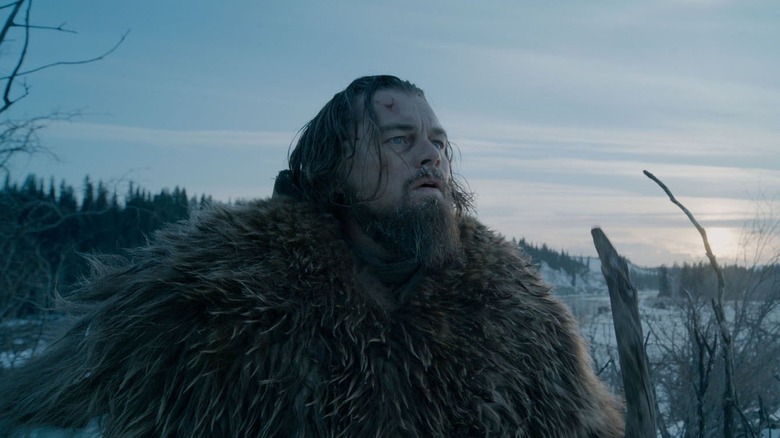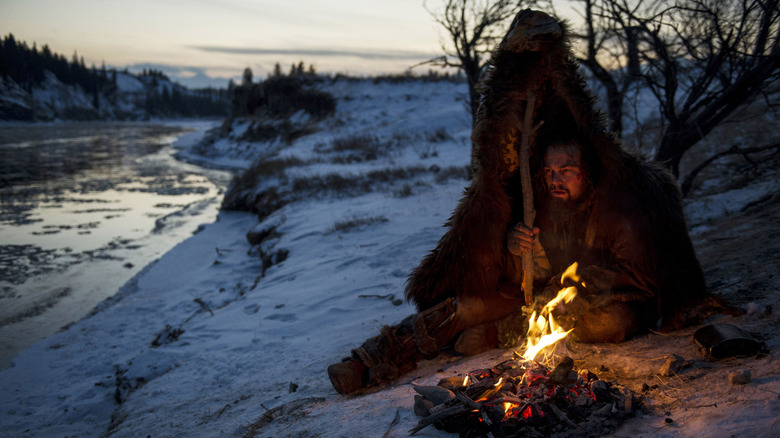Every Day On The Revenant Set Was A Race Against Time
Working on Alejandro G. Iñárritu's "The Revenant" was grueling, causing numerous crew members to quit. Leonardo DiCaprio, who would go on to win the Oscar for his rugged performance, confessed in The Hollywood Reporter: "I can name 30 or 40 sequences that were some of the most difficult things I've ever had to do. Whether it's going in and out of frozen rivers, or sleeping in animal carcasses, or what I ate on set. [I was] enduring freezing cold and possible hypothermia constantly."
"The Revenant" follows frontiersman Hugh Glass who is left at the mercy of Mother Nature by his crew members on a fur trading expedition in the 1800s. The film details his arduous ordeals through the dense woods and freezing snow as he tries to find civilization, battling Native Americans and almost getting mauled by a bear along the way.
What made the shoot so notoriously complex and costly was not only filming in the remote hinterlands during severe weather conditions, or shooting the film chronologically for DiCaprio to harness Glass' emotional journey, but also cinematographer Emmanuel "Chivo" Lubezki's decision to only use natural lighting. This greatly intensified the common film set fear of "losing the light."
Every single shot could only be filmed within a particular time frame and with no mistakes in order to capture the ideal amount of light or darkness. "It's 4 o'clock, and you've got an hour and a half of daylight, and it's not the light he wants to shoot in," a crew member explains in The Hollywood Reporter. "If you want to seamlessly stitch [the footage] together, it's not going to match." This also meant that any of the action sequences, particularly the Native American conflict that plays out in real time with a large cast, had to be carefully choreographed and rehearsed before filming.
Was this constant race against time worth it? Using natural lighting certainly made filming "The Revenant" more difficult, but there are many reasons why Iñárritu and Lubezki's choice makes for a unique cinematic experience.
What does natural light bring to the film?
Iñárritu films his landscapes with an expansive awe. The use of the natural sun and moon fills the screen with incredible colors and texture. The shots have a majestic yet glacial beauty, especially because they are organic and not an artificial image on a controlled set. "Artificial lighting gives the director and cinematographer complete control over how an image will look. Filmmakers need artificial lighting, so they can use any preference with camera settings and still produce a well-lit image. 'The Revenant' [gives] this power back to nature," Jake Fallin writes.
A campfire sequence filmed at night was the only scene that had to use light bulbs. For the rest of the film, "The Revenant" uses the authentic sunlight to create a visceral experience that immerses the audience in the historical American wasteland. Lubzeki elaborates on the cinematography in Variety:
"The idea of using natural light came because we wanted the audience to feel, I hope, that this stuff is really happening. Natural light is very complex because it's constantly changing, which of course is a problem for continuity, but it's beautiful. And that constant transformation of nature is a theme of the movie."
In the same interview, Lubezki reveals that he planned to shoot "The Revenant" on celluloid, but the format could not capture the light of dusk and dawn properly. The cinematographer was thrilled with his decision to use natural light and digital cameras because it "allowed us to (work) without any noise or grain between the audience and the actor. It's a little like watching everything through a window; it's clean, and there's no texture between you and the character."
The end result of all the hard work on "The Revenant" is utterly breathtaking. While the shoot itself raises some important questions about the ethics of filming in extreme conditions and overworking film crews, it is difficult to deny the magnificence of Iñárritu's brutal spectacle. Without the use of natural lighting, the audience would never behold such primal images as DiCaprio's frozen purple lips and anguished breath misting the camera lens. You feel every weary moment of Glass fighting the elements. "The Revenant" does not romanticize the wilderness, it uses authentic light to capture all of its harsh beauty.

